Where can you install an air conditioner: choosing the optimal location for installation in a private house or apartment
How many times in the summer, when the heat comes, or in late autumn, when the apartment is uncomfortable without heating, do we all remember that we were going to install an air conditioner, but never got around to it? Agree, spring will be followed by summer in any case, and if the issue is not resolved, then we will again languish in the heat. No ventilation or fans, and in winter heaters will not save us.
We still need to make up our minds and tackle the issue of choosing an air conditioner with a whole list of convenient functions that will make our life more comfortable. We will help you navigate the sea of various climate control equipment, tell you where you can install the air conditioner, and how to decide on the optimal location for installation.
The content of the article:
Optimal air exchange in the apartment
According to statistics, a person spends 16 hours a day indoors at work or at home, which is why the issue of ventilation and air renewal is so important.
To ensure a healthy and comfortable microclimate in your home, you should follow several steps:
- check the operation of the exhaust system
- use air supply devices if necessary
- install air conditioner
The correct functioning of the exhaust ducts can be checked in a simple way using a strip of paper; during normal operation, the air flow attracts it to the ventilation grille. The “repulsive” effect signals the presence of reverse draft.
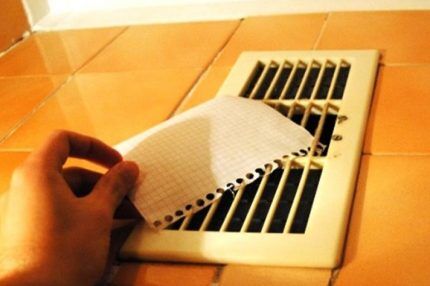
To eliminate the problem, it is advisable to install a fan with a check valve. The next stage will be the installation of supply valves in metal-plastic windows. In the case of wooden frames of an outdated type, the issue of air flow is resolved spontaneously, without valves.
And finally, the final step. For complete comfort, i.e. to obtain coolness in hot weather and warmth in cold weather, climate control equipment is installed (after deciding the issue of choosing the model and location of the air conditioner, since the efficiency of operation depends on proper placement).
General information about air conditioners
To maintain an optimal comfortable temperature in the house (usually from 18 degrees to 25), it is necessary that both systems: climate control and ventilation, work harmoniously and complement each other. Understanding the mechanism of action and features of climate control equipment will help you correctly assess the needs of the room and make a rational choice.
Standard Equipment Classification
By design, air conditioners are divided into two classes:
- monoblock (represent a system, all components of which are immersed in a common housing);
- split systems (include two interacting blocks: external and internal).
The first class includes floor mobile models And window air conditioners. They are distinguished by their simplified design, extremely simple installation and low price. Compact window units are not very popular in our country due to their noisy operation and inconvenient installation; they darken the room and spoil the appearance of the window.
Mobile air conditioners, small but heavy (up to 50 kg of installation with a hose), are in demand among summer residents due to their mobility, but the disadvantages are a small cooling area and a high noise level.
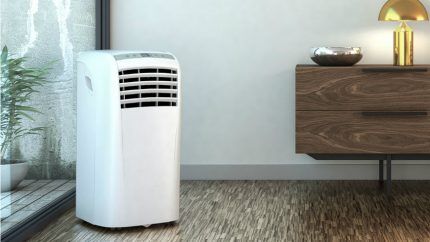
Among the various floor-mounted mobile air conditioners, models without a corrugated hose have appeared; they are much quieter, more mobile and safer (the hose, heating up to 60 degrees, can burn).
Unlike the above options, split systems are characterized by small sizes and reduced noise levels.
Duct and cassette air conditioners mounted in the space behind a suspended ceiling and false walls. Column and precision air conditioners require floor installation; these types of air conditioners belong to semi-industrial systems and are used for installation in technological rooms, museums and shops, restaurants and hotels.
Wall-mounted split systems are designed for rooms from 15 to 90 square meters. meters, they are considered the best air conditioners for furnishing an apartment.
Guidelines for choosing a climate control unit
In order for the air conditioner to function for a long time and properly with maximum efficiency, the following conditions must be met:
- choose a model that suits the parameters of the given room;
- install the device in a qualified manner;
- use the unit in accordance with the operating instructions and carry out regular maintenance.
In progress choosing an air conditioner it is necessary to take into account such characteristics as the total area of the room and the number of people in it. It is necessary to take into account the orientation to the cardinal points and the presence of windows with blinds, as well as the power of heat-generating equipment.
For cooling 10 sq. meters, on average 1 kW is required, therefore, when calculating the required refrigeration capacity, you need to divide the area of the room by 10; In addition to this main parameter, other dimensions also affect the value.

For a room located on the south side, with panoramic glazing and a large amount of equipment (computer, refrigerator, TV, etc.), the calculated value of optimal cooling should be increased by 20%. An air conditioner with insufficient power, even with proper operation, will not cope with its functions.
Split system functions
The most necessary and popular functions of a split system, for which the buyer installs climate control equipment, are heating, cooling and ventilation, dehumidification and air purification.
To properly use the room heating function, you should use the “all-season block” add-on, which is responsible for warming up the crankcase and reducing the risk of compressor wear.
In ventilation mode, it is convenient to have several speeds. Then, without changes in temperature, it is advisable to adjust the strength of circulation of stagnant air masses.When the humidity level increases, the dehumidification mode will help out, allowing you to stabilize the indicator and prevent its negative impact.
Also useful are additional options such as a timer, regulation of air flow directions and night mode, the use of which will add comfort when operating the air conditioner.
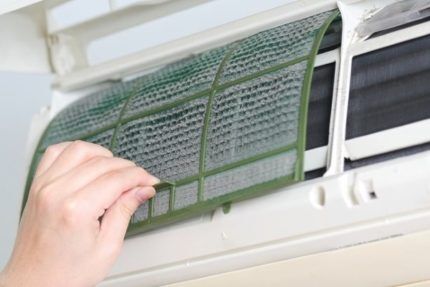
However, one of the most important and necessary functions is to purify the air before entering the room. This occurs through a filtration process using a standard coarse filter (a plastic mesh that requires regular inspection), which traps dirt, large dust particles and animal hair.
Fine filters that retain particles of several microns are also used. Some models are complemented by carbon, which remove unpleasant odors, and electrostatic, which eliminate various allergens, fine dust and pollen.
Parameters of wall-mounted air conditioner
Filters, a 3 or 4 speed fan, horizontal blinds and a condensate tray, necessary to perform all of the above functions, are components of the indoor unit of a wall-mounted split system (or simply “household air conditioner”).
Wall type of air conditioner considered the most common and deservedly popular for private houses and apartments, with a power of 2 - 7 kW it cools small rooms from 15 to 75 sq. m. m.
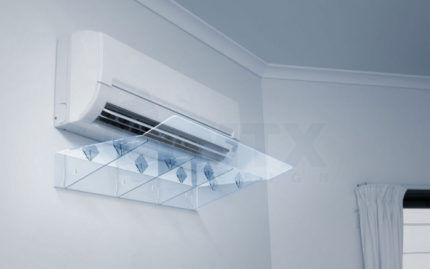
Small dimensions (height from 20 to 30 cm, depth from 16 to 20 cm and width in the range of 0.7-1.6 m), complete with simple installation and easy operation, have become the main advantages of this model. The advantage is the low noise level achieved by installing the compressor on the street side.
When working to heat a room, the outdoor unit plays the role of an evaporator, and the indoor unit plays the role of a condenser. In the case of cooling mode, each block performs the opposite function.
Traditional block placement
The external and internal blocks of the wall-mounted air conditioner communicate with each other using a freon route. These are copper tubes with circulating freon (R22, R410a or R32). Control and power cables are also being laid, as well as a plastic tube for discharging condensate to the street.
The optimal length of the line between the units should be no more than 5 m (this applies more than others to inverter air conditioners); in cases of a larger value, refueling with freon will be required. This limitation affects the choice of location of the climate system, where to properly install the external and internal air conditioner units in the house.
The simplest “standard” installation option involves placing both blocks in accessible places, with a communications length of no more than five meters (PVC, flex and pipe), and a drainage pipe of three meters.The thickness of the brick wall between the blocks should not exceed 0.8 m, and the concrete walls should not exceed 0.6 m.
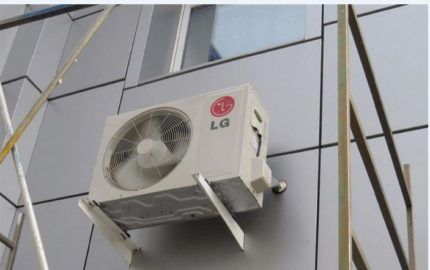
The internal part of the system is strengthened in the upper part of the wall near the window, the external part with the compressor is under the window, the distance between them is directly proportional to the reduction in the power of the unit.
Based on this, the shorter this interval, the more efficiently the air conditioner operates. Therefore, it is advisable to place the indoor unit on the same wall as the external one. But at the same time, each manufacturer calculates a personal maximum between blocks.
Location of the external part of the system
The external unit of a wall-mounted air conditioner is one of the most important parts of a split system. It includes the following elements: compressor, fan and condenser, control board and four-way valve. In order for all these devices to interact efficiently and perform their functions as efficiently as possible, it is necessary to take the issue of unit placement very seriously.
After selection and purchase, each consumer is faced with the task of how and where to properly hang or place air conditioner outdoor unit, since location and conditions are very important.
During the selection process, the following parameters must be taken into account:
- device weight (usually between 20-70 kg);
- wall material and the possibility of airflow;
- unobstructed access for maintenance;
- protection from environmental factors.
Installation of the outdoor unit is most often carried out on the outside of the building, and it is necessary to check the strength of the wall section (fastening to a dilapidated surface is prohibited). The quality of fastening is also strictly controlled in the presence of a layer of insulating materials (anchors and brackets are used with a large margin of safety).
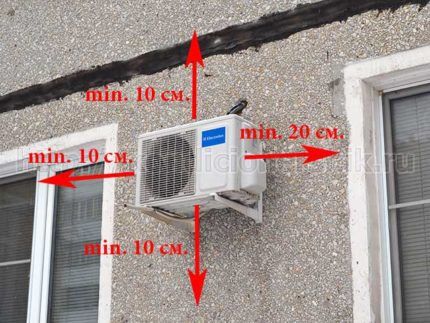
To ensure free air circulation and prevent overheating, the block is placed at a distance of at least 15 cm from the wall and 20-30 cm from the nearest obstacle, preferably on the shady side. Installation under a window with an opening sash is made for ease of maintenance.
In rare cases, when installed on upper floors, the outdoor unit is placed on the roof or an unglazed balcony (provided there is sufficient airflow).
Optimal location for the internal component
The installation location of the indoor unit should be determined taking into account the rules for placing the air conditioner in the house (room) and the operating characteristics of the equipment.
Therefore, when choosing the optimal placement of a block, it is necessary to ensure compliance with the following requirements:
- distances to the external unit, ceiling, walls and other obstacles;
- availability of space to heat sources;
- free circulation of system air flow;
- the likelihood of a person’s constant presence in the risk zone.
Air is taken from the room through the top of the device; therefore, there should be a space of at least 10-15 cm to the ceiling and side surfaces.Installation above horizontal surfaces (shelf, chest of drawers or closet) is not recommended if the distance is less than 0.7 - 1.0 meters.
Due to the fact that the temperature sensors of the unit react to nearby air flows, you cannot install the air conditioner near radiators, a boiler, a gas stove and other thermal resources, as this will force the air conditioner to work continuously for cooling and will lead to rapid wear.
And the main problem in finding the location of climate control equipment is the least likelihood of a negative impact on people’s health. Each room of the apartment has individual requirements, but the basic condition must be met everywhere - the cold flow should not fall into places where household members are present for a long time.
The highest concentration of cooled air is observed at a distance of 2-3 meters from the device, then the cold dissipates.
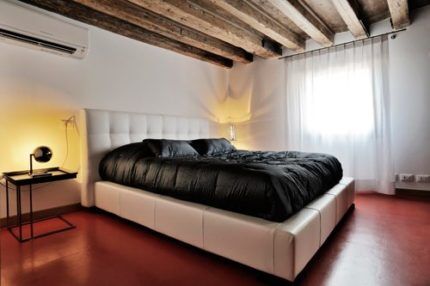
Based on this, in the bedroom the air conditioner is installed on the wall at the head of the bed, on the side of the bed. In the living room, the optimal place will not allow the sofa and dining table to fall into the three-meter risk zone. In the children's room, it is recommended to turn on the air conditioner while the child is away.
In the kitchen, when there is an abundance of appliances (radiator, refrigerator, stove), window air conditioners and corner compact models of the device are often chosen. However, due to unstable humidity and temperature, the placement of climate control equipment not adapted to such conditions is prohibited by manufacturers.The problem is usually solved by installing a fan in the hood.
Air conditioning options in a private house
When planning and calculating an air conditioning system in a private house, they are usually guided by the same rules as in other rooms - the size of the area, sources of excess heat, the number of people living, etc.
But when building a new house, there is a chance to thoroughly think through the placement of both furniture and ventilation and air conditioning system devices so that the control sensors are correctly placed and do not misinform the climate system.
When choosing an equipment model for a private home, many more options are considered (many types of air conditioning are difficult to install in ordinary apartment buildings).
Therefore, in addition to standard split systems, duct and cassette air conditionersusing an attic or attic. They use universal ceiling-floor or multi-systems (for country houses from 150 sq. m. multi-zone VRF and VRV systems).

And finally, several proven decorating methods will help you choose where to install the air conditioner correctly so that it looks harmonious in the apartment:
- air conditioner decoration;
- camouflage behind a decorative screen;
- placement in a niche or on an open shelf.
If there is no niche in the wall, if there is no screen or shelf in the desired tone, simple alternative design options are possible.
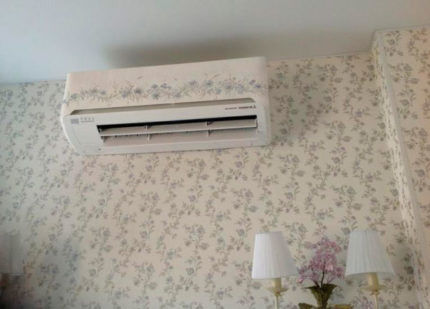
Photographic printing consists of covering the façade of an air conditioner with individual stickers to match the surrounding environment. The master paints the body of the air conditioner with artistic painting using acrylic paints or a special spray gun. In any case, the air conditioner will blend harmoniously with the design of the room.
The principle of installing an air conditioner is generally simple, but details and little things are important; they will help the equipment work more efficiently and make us feel more comfortable.
Conclusions and useful video on the topic
Tips for buying an air conditioner, how to buy a quality unit and not overpay for it?
Design, pros and cons of a mobile floor air conditioner:
Detailed instructions for switching the air conditioner to heat:
We all want our home to breathe freshly and easily, which means we need to try to choose climate control equipment that will fit into the home ventilation system and work in tandem with it. And the main thing will be not only the equipment model, but also where this air conditioner is installed.
Everyone will install an air conditioner in their home based on their own tastes, design and room capabilities, but a few of the most necessary strict rules will have to be followed.
If the information in the article was useful to you or gave rise to an interesting idea, share your ideas in the comments.



